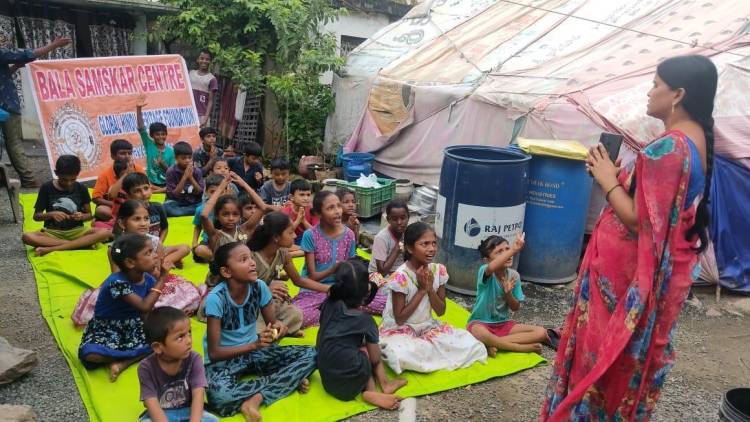[GHHF] Bala Samskar Kendras – Students learned about Mangal Pandey, his revolt against British and his death by hanging.
 Global Hindu Heritage Foundation started with a mission to preserve, protect and promote the richness of Sanatana Dharma. To accomplish this goal, we felt that it is the utmost of the hour to teach about our culture, traditions, mantras, rituals, morals, and our national heroes. Also work toward the renovation and revival of Hindu Temples, open the neglected Temples, protecting the animals, and protecting the environment. This week the students learned about the patriotism of Mangal Pandey.One thing becomes clear to all of us if we observe the independence movement of the country carefully. They fought not only to drive out the foreign invaders but also to maintain the culture and customs of this country. Foreign Muslim looters, foreign Christian looters have not only robbed us but also committed many atrocities disrespecting our cultural roots. Due to this, the flames of rebellion were raised on a large scale among the common people as well. The proof of that is the first sepoy mutiny in the country's independence movement.
Global Hindu Heritage Foundation started with a mission to preserve, protect and promote the richness of Sanatana Dharma. To accomplish this goal, we felt that it is the utmost of the hour to teach about our culture, traditions, mantras, rituals, morals, and our national heroes. Also work toward the renovation and revival of Hindu Temples, open the neglected Temples, protecting the animals, and protecting the environment. This week the students learned about the patriotism of Mangal Pandey.One thing becomes clear to all of us if we observe the independence movement of the country carefully. They fought not only to drive out the foreign invaders but also to maintain the culture and customs of this country. Foreign Muslim looters, foreign Christian looters have not only robbed us but also committed many atrocities disrespecting our cultural roots. Due to this, the flames of rebellion were raised on a large scale among the common people as well. The proof of that is the first sepoy mutiny in the country's independence movement.
The British recruited Indians as soldiers with Indian money and ruled the Indians as slaves. So many Indians served as sepoys in the British army. Many did the work willingly. But when the Indian sepoys were told to kill a cow, the most revered of Indians, and apply the fat to the bullets and use them, their morals, which had been dormant until then, awakened their cultural roots and made them fight against the British government. "Looking like this, there is no doubt that Gomata was the cause of the Sepoy Mutiny, which is said to be the starting point of the country's freedom struggle."
Mangal Pandey was born on 19 July 1827 to Nagwada Diwakar Pandey in Uttar Pradesh. As a child, he attended science school and studied surgery. Mangal Pandey served as a sepoy in the 34th Bengal Regiment in the British Army. The British used to give the sepoys bullet cartridges made of cow fat. The cartridge was thought to be greased with animal fat, mainly from cows and pigs, which Hindus and Muslims, respectively, could not eat (the former a holy animal of the Hindus and the latter being abhorrent to Muslims). Before use, the cartridges had to be bitten at one end. Some Indian troops in some regiments believed it was a deliberate act by the British to defile their religions.
He bit his mouth and removed the skin of the tusks, and as he did not want to use the tusks coated with cow fat, his self-esteem, which had been dormant till then, rose up, and he gathered his fellow sepoys and raised a voice of defiance against the British government. They killed two British officers and started a mutiny. Many heroes like Jhansi Lakshmibai, Maratha Peshwa Nanasaheb, Tantia Tope, who had been waiting for an opportunity till then with the spirit of military rebellion, fought against the East India Company. After that the British with a large army crushed the movement and imprisoned Mangal Pandey and hanged him on 8th April, 1857. Remembering Mangal Pandey means remembering those military heroes who fought for the country's pride and for Gomata.
It seems really shameful that today's generation, born in this land, who fought for the cow, for Dharma despite knowing that their lives will be lost, live as if nothing is being done even though lakhs of cows are being killed, Dharma and temples are being attacked around them in independent India. Today's generation needs to be made soldiers who will fight for dharma and country.
Donations are appreciated;
By Zelle: ghhfusaorg@gmail.com
PayPal: savetemples.org
By Check: You can also send a check payable to GHHF,14726 Harmony Lane, Frisco, TX 75035.
It is tax-deductible.
By Rupees: call 601-918-7111; +91 83096 43979





















 Urgent support needed for Bangladesh Hindus
Urgent support needed for Bangladesh Hindus 







